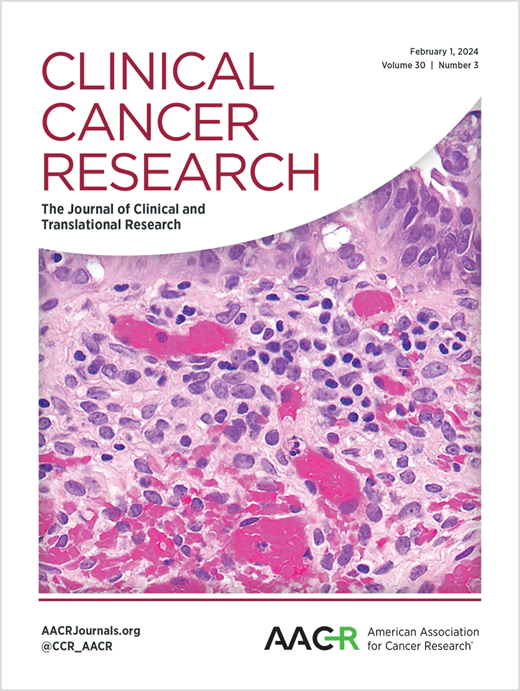Clinical validity of repeated circulating tumor cell enumeration as an early treatment monitoring tool for metastatic breast cancer in the PREDICT global pooled analysis
IF 10
1区 医学
Q1 ONCOLOGY
引用次数: 0
Abstract
Purpose: The aim of PREDICT was to confirm clinical validity and the potential for clinical utility of serial circulating tumor cell (CTC) enumeration in metastatic breast cancer (MBC) patients focusing on its prognostic value in different breast cancer subtypes and clinical settings. Experimental design: In total, 4436 individual patient-level data with CTC results from both baseline and one follow-up (CellSearch®; Menarini Silicon Biosystems) were analyzed to evaluate the association between CTC detection and overall survival (OS) in the full patient cohort and separately for tumor and treatment types. Results: Using the cutoff ≥ 1 CTC for CTC positivity, 913 (20.6%) patients had 0 CTCs at both time points (neg/neg), 325 (7.3%) and 1189 (26.8%) patients converted from CTC negative to CTC positive (neg/pos) or vice versa (pos/neg), while 2009 (45.3%) patients had at least one CTC at both time points (pos/pos). Median OS for the neg/neg, neg/pos, pos/neg and pos/pos group was 45.6, 26.1, 32.3, and 17.3 months, respectively (P < 0.0001, global log-rank test). CTC responders (pos/neg) showed a lower risk of death compared to CTC non-responders (pos/pos) (HR 0.48, 95% CI 0.44 – 0.53). Similar results were obtained in subgroup analyses according to hormone receptor and HER2 subtype, treatment type, and with a ≥ 5 CTC cutoff for CTC positivity. Conclusions: Follow-up CTC assessments strongly predict OS independently from tumor subtype and treatment. New randomized trials to define the clinical utility of CTC monitoring for risk stratification and as an early response marker in MBC are urgently needed.在PREDICT全球汇总分析中反复循环肿瘤细胞计数作为转移性乳腺癌早期治疗监测工具的临床有效性
目的:PREDICT的目的是确认循环肿瘤细胞(CTC)序列计数在转移性乳腺癌(MBC)患者中的临床有效性和临床应用潜力,重点关注其在不同乳腺癌亚型和临床环境中的预后价值。实验设计:共有4436例个体患者水平的CTC数据,包括基线和一次随访(CellSearch®;对美纳里尼硅生物系统公司(Menarini Silicon Biosystems)进行分析,以评估全患者队列中CTC检测与总生存率(OS)之间的关系,并分别针对肿瘤和治疗类型进行分析。结果:以≥1个CTC为CTC阳性的临界值,913例(20.6%)患者在两个时间点(阴性/阴性)都有0个CTC, 325例(7.3%)和1189例(26.8%)患者从CTC阴性转化为CTC阳性(阴性/pos)或反之(pos/阴性),而2009例(45.3%)患者在两个时间点(pos/pos)至少有1个CTC。阴性/阴性、阴性/pos、pos/阴性和pos/pos组的中位生存期分别为45.6、26.1、32.3和17.3个月(P <;0.0001,全局log-rank检验)。与CTC无应答者(pos/pos)相比,CTC应答者(pos/pos)的死亡风险较低(HR 0.48, 95% CI 0.44 - 0.53)。根据激素受体和HER2亚型、治疗类型以及CTC阳性临界值≥5的亚组分析结果相似。结论:随访CTC评估可以独立于肿瘤亚型和治疗预测OS。目前迫切需要新的随机试验来确定CTC监测风险分层和作为MBC早期反应标志物的临床应用。
本文章由计算机程序翻译,如有差异,请以英文原文为准。
求助全文
约1分钟内获得全文
求助全文
来源期刊

Clinical Cancer Research
医学-肿瘤学
CiteScore
20.10
自引率
1.70%
发文量
1207
审稿时长
2.1 months
期刊介绍:
Clinical Cancer Research is a journal focusing on groundbreaking research in cancer, specifically in the areas where the laboratory and the clinic intersect. Our primary interest lies in clinical trials that investigate novel treatments, accompanied by research on pharmacology, molecular alterations, and biomarkers that can predict response or resistance to these treatments. Furthermore, we prioritize laboratory and animal studies that explore new drugs and targeted agents with the potential to advance to clinical trials. We also encourage research on targetable mechanisms of cancer development, progression, and metastasis.
 求助内容:
求助内容: 应助结果提醒方式:
应助结果提醒方式:


